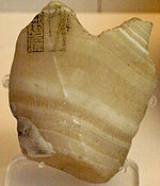
Sekhemib-Perenmaat
Overview
Sekhemib, or Sekhemib-Perenma´at, is the horus name of an early Egyptian
king
who ruled during the 2nd dynasty
. Similar to his predecessor Seth-Peribsen
, Sekhemib is contemporarily well attested in archaeological
records, but he doesn´t appear in any posthumous document. The exact length of his reign is unknown and his burial site has not yet been found.
Sekhemib´s name is known from seal impressions and from inscriptions on vessels made of alabaster
and breccia
.
Early Dynastic Period of Egypt
The Archaic or Early Dynastic Period of Egypt immediately follows the unification of Lower and Upper Egypt c. 3100 BC. It is generally taken to include the First and Second Dynasties, lasting from the Protodynastic Period of Egypt until about 2686 BC, or the beginning of the Old Kingdom...
king
Pharaoh
Pharaoh is a title used in many modern discussions of the ancient Egyptian rulers of all periods. The title originates in the term "pr-aa" which means "great house" and describes the royal palace...
who ruled during the 2nd dynasty
Second dynasty of Egypt
The second dynasty of ancient Egypt is often combined with Dynasty I under the group title Early Dynastic Period. It dates approximately from 2890 to 2686 BC. The capital at that time was Thinis.-Rulers:...
. Similar to his predecessor Seth-Peribsen
Seth-Peribsen
Peribsen is the serekh name of an early Egyptian king who ruled during the 2nd dynasty. Unlike many other pharaohs of this dynasty, Peribsen is well-attested in the archaeological records...
, Sekhemib is contemporarily well attested in archaeological
Archaeology
Archaeology, or archeology , is the study of human society, primarily through the recovery and analysis of the material culture and environmental data that they have left behind, which includes artifacts, architecture, biofacts and cultural landscapes...
records, but he doesn´t appear in any posthumous document. The exact length of his reign is unknown and his burial site has not yet been found.
Sekhemib´s name is known from seal impressions and from inscriptions on vessels made of alabaster
Alabaster
Alabaster is a name applied to varieties of two distinct minerals, when used as a material: gypsum and calcite . The former is the alabaster of the present day; generally, the latter is the alabaster of the ancients...
and breccia
Breccia
Breccia is a rock composed of broken fragments of minerals or rock cemented together by a fine-grained matrix, that can be either similar to or different from the composition of the fragments....
.

